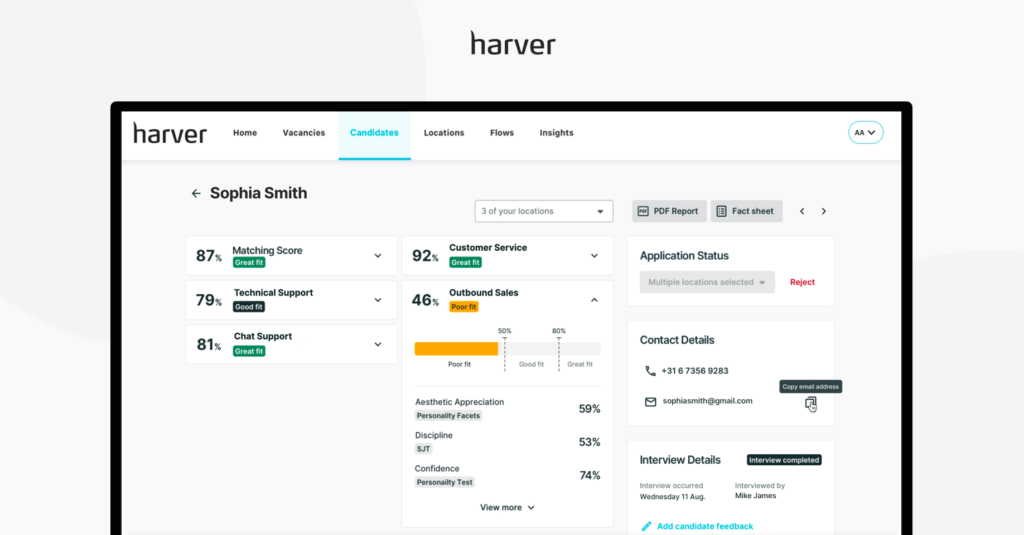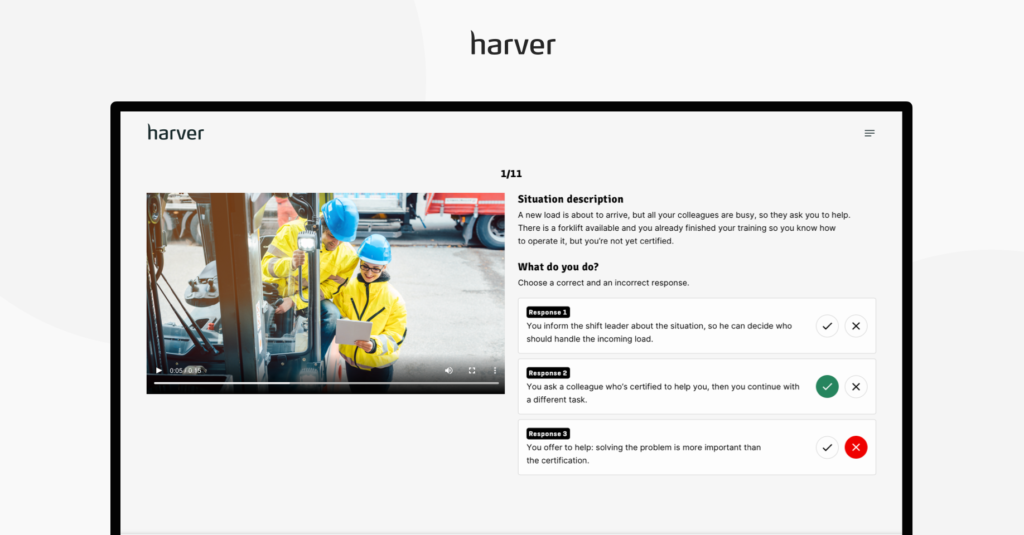According to the US Bureau of Labor Statistics, the average turnover rate across all industries in the U.S. is between 12% to 15% annually. Employee turnover in the warehouse industry stands at a whopping 46.1%.
Why is employee attrition in this industry so high? Misaligned expectations about the job, low job security, long days and intensive work, low pay, no defined career path, no opportunity for growth, and the list could go on.
Yet, high employee turnover shouldn’t be a given if you work in warehousing. It doesn’t have to be a “part of doing business”. In fact, employee turnover in the warehouse industry can be prevented.
Here’s how.
What's in?
Like what you see?
Don’t miss out. Subscribe to our quarterly digest to get the latest TA and TM resources delivered right to your inbox.
1. Optimize candidate sourcing
If you want to hire the best employees and reduce employee turnover, optimize your recruitment funnel right at the very start – where you source applicants. Because the type of talent that enters your funnel will dictate the quality of your hire.
By adopting a data-driven approach to sourcing, you can easily find out where the top-quality candidates are coming from – the people who stay with your organization, so that you can focus your efforts in that channel, and hire more of them. Also, check out which source churned employees came through, if there’s a commonality, stop using it.
2. Optimize candidate screening and selection
Even in a tight labor market, there is no point in hiring everyone who applies. It won’t end well. Just because you’re looking for applicants to fill entry-level roles, doesn’t mean everyone who applies will be suitable. If you aren’t selecting the top talent for your roles, it’s likely you’ll be experiencing higher turnover.
You aren’t looking to future-proof your organization by hiring candidates who possess high learning agility, you are looking for employees who possess certain skills and attitudes that will allow them to excel in your warehouse roles.
To work in your warehouse, you want applicants who are organized, solution-oriented, capable of handling dispute resolution, work well in a team, and are fast learners. If you hire candidates who are a poor job-fit, it’s likely they’ll underperform, quit, or need to be let go.
To find these people, assess them using pre-employment assessments such as a personality questionnaire, a cultural fit assessment, or a multitasking test, all of which can be developed to meet your company’s hiring needs. These are assessments that evaluate applicants’ skills and attitudes, as well as their cultural fit.
In the Harver platform, for example, you can set a minimum score of say 80/100 for assessments, and anyone who meets that threshold is automatically progressed through to interview or your next step. The two-way matching technology used by Harver shows you not only what skills applicants have, but also what roles they’d fit the best.

In the image above, you can see the profile of one candidate, with matching scores for specific roles, as well as an overall matching score. The job profiles displayed on the candidate profile page will be different for a warehouse, but they’ll enable you to see in one dashboard all the information needed to make data-driven decisions when selecting candidates.
Oftentimes, especially in entry-level roles where all candidates look the same on paper, mishires are a result of not optimizing screening. Automating the screening process and only selecting applicants to move forward in your funnel based on their skills, their competence, and their organizational fit will make your life easier in the long run.
If you’d like to see the Harver matching technology in action, you can book a demo below.
Ready to transform your hiring process?
3. Manage candidate expectations
One of the biggest contributors to high employee turnover is misaligned expectations. Because of the low barriers to entry-level jobs, if a candidate doesn’t like what they see as a new hire, they can easily quit and find a new job, in a different low-complexity job. In some cases, this can happen before their first day, resulting in a no-show.
The simplest way to reduce early attrition is to manage candidate expectations from the get-go.
This doesn’t mean recruiters have to individually educate the candidates about the realities of the role, far from it. It’s much easier, fairer, and faster for you to set expectations in a transparent and engaging way that is consistent for all applicants while giving each applicant a realistic job preview (RJP).
An RJP is where you showcase the day-to-day reality of the role, the work environment, even some critical situations employees frequently find themselves in while working in your warehouse. You can embed RJPs into the application with a video, or you can take it one step further and combine selling with selecting by using situational judgment tests (SJT).
SJTs are where you present candidates with a standard scenario they might encounter in your warehouse, and ask them how they’d respond. It not only gives applicants a sneak peek into what the role entails, but it also allows you to assess their behavior and identify which candidates react the way your top performers do.

4. Showcase company culture
The people who apply to entry-level roles aren’t exclusively applying to your warehouse. They are unlikely to be familiar with your culture, or your organization. Educate them throughout the application process on the merits of working for you: showcase the best bits about your culture by embedding testimonials from existing employees, or highlighting the work environment.
Here’s, for example, the candidate experience created by Albert Heijn. Applicants get to see what it’s like to work there, and can decide if they like the culture and work environment before any contact with the recruiting team takes place.
Ready to transform your hiring process?
Give candidates the option to decide if they’re going to enjoy working for you or not. This might sound counterintuitive, but letting candidates self deselect from the application process is better than hiring unsuitable applicants, investing time and money onboarding them, only for them to attrit soon after starting.
5. Manage scheduling expectations
Don’t hide how your warehouse operates, be transparent with candidates and provide information regarding work schedules. Warehouse work can involve long hours doing hard work. Don’t sugarcoat this, it will only lead to employee attrition.
Share with candidates how your scheduling works. What the average shift length is, how often you rewrite the schedule, what flexibility (if any) there is in the schedule. Tell applicants the truth and let them decide if it suits them.

49%
of hourly employees are willing to take a pay cut in exchange for more control over their schedules.
Source: Shiftboard
If you operate a flexible schedule, shout about this during the recruitment process. So many warehouses don’t – do you offer flexi-time? Can employees trade shifts? Can they accrue half-day vacation increments? Can they take unpaid leave?
6. Highlight training and growth opportunities
There is a persistent belief that warehouse roles don’t lead to a career. But this is untrue. Educate candidates during the application process about where this job might lead. Yes, it’s an entry-level role they’re applying for, but it’s only the start.
Entry-level applicants aren’t typically looking to work for you to upskill, or for a long-term career, they want job security and a paycheck now. Highlight your training and growth opportunities and let them see that this is only the start of something, and get them excited about future career prospects if they stick with you.
Tactics to reduce employee turnover after hiring
7. Deliver a seamless onboarding experience
Candidates will have experienced a snippet of your company culture while they went through your application process, but their actual first experience of working at your organization is your onboarding process.
Delivering a seamless onboarding experience will help transition candidates from applicant to employee, making them feel a part of your organization, which should help increase retention rates.
Just as candidates were keen to hear about the status of their application, so too they’ll be excited to hear about when they start, their job offer, and training schedule. If you operate a quick and efficient recruitment process, make sure this feeds into your onboarding too.
8. Set new employees up for success
As well as onboarding new employees into your organization, set them up for success by equipping them with the tools, the knowledge, and the know-how to succeed in their new warehousing role.
Provide training as part of your onboarding process that properly trains employees, helping them understand how to complete their tasks. By giving them the tools for success, they’ll feel better capable of handling difficult situations where they might otherwise panic and quit.
9. Invest in career development programs
If staff have to leave your warehouse to get better pay or a promotion, you need to invest in personal career development programs and supply development opportunities to encourage them to stay.
While employee training courses might be an expensive outlay, it’s not as expensive as continually recruiting to feed the revolving door of employees. Make sure new employees know that you’re invested in their futures, in their career development.
Entry-level staff can view their job as temporary, but by providing a clear training and development path for their growth, highlighting the steps they need to take to go from warehouse worker to manager, demonstrates that they’re a part of your team, that just because they’re entry-level employees, they’re not disposable workers.
When employees feel appreciated and cared for, that you’re taking an active role in managing their careers, they’ll feel more confident in their work, and this can only positively impact productivity and retention.
10. Improve warehouse culture
While many warehouses talk culture, few work to improve theirs. Improving warehouse culture can be as simple as making one of your core values to treat employees like family. When you demonstrably care for your employees’ well-being, when you over-communicate, recognize hard work, offer bonuses or other incentives, you’re creating a strong company culture that people will want to be a part of.
11. Keep the warehouse tidy
A warehouse is never going to be a spotless work environment, people are constantly moving around, forklifts are working, boxes are unpacked, items are moved, and all of this needs to be managed.
By keeping the warehouse tidy, organized, and clutter-free, you reduce the risk of workplace accidents. When employees aren’t worrying about trip hazards or being run over by a loaded forklift truck, they feel safer and can focus their minds on the labor-intensive job at hand.
12. Implement rewards system
Rather than constantly recruit new employees, focus your efforts on retaining existing employees. It’s a far cheaper and more effective staffing solution in the long run. You don’t need to go wild, keep things simple.
Begin by introducing incentive-based pay to encourage employees to stick around. Reward employees for long service. People like working towards a goal, so set goals and reward staff for achieving them. Give employees the opportunity to control their level of performance and ultimately their potential reward.
Offer bonuses, increase holiday days, publicly acknowledge hard work. Set milestones and reward employees accordingly.
13. Support employee work-life balance
Employee retention should be a strategy you implement, not an outcome. When employees feel overwhelmed or taken advantage of, that’s when productivity decreases and staff turnover increases. Employees have a life outside of work, allowing flexibility for employees to balance their work and life improves employee satisfaction.
Next steps
Taking steps before, during, and after the application process, can all work toward aiding employee retention, but if you want to treat the root cause of the problem when it comes to turnover in the warehousing industry, you need to address your recruitment strategy first.
At Harver, we support large enterprises in decreasing employee attrition by enabling them to hire better, faster, and in a fundamentally fair manner. We do this by helping our clients streamline their volume hiring processes and gain visibility into their recruitment data so that they can make data-driven decisions when selecting candidates, at scale.
If you’d like to see how Harver can help you reduce employee turnover, you can book a demo below.
Ready to transform your hiring process?

